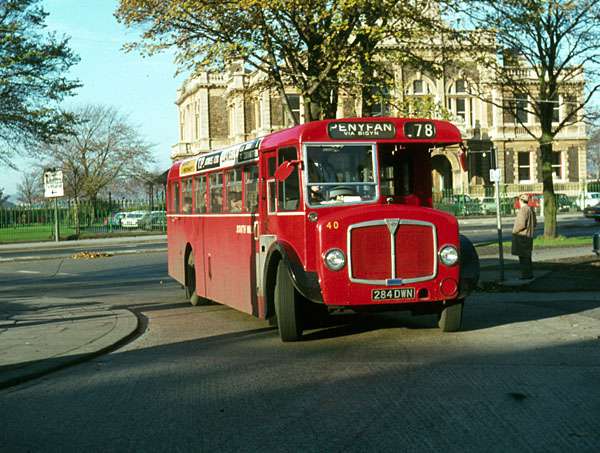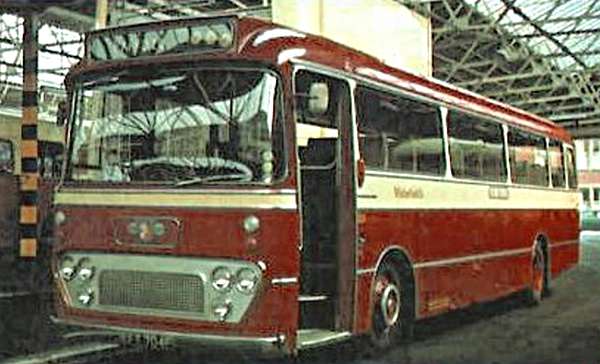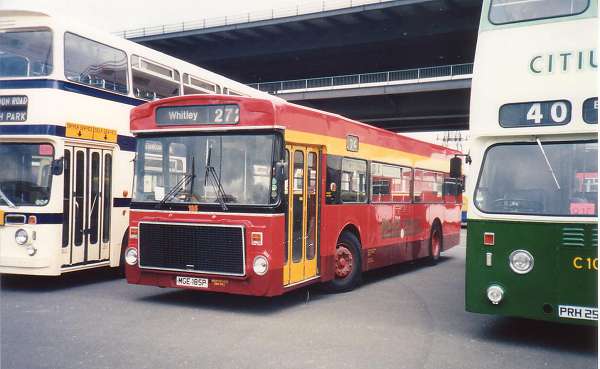Special Bus Profiles
Knowing about the double deckers specific designed to negotiate the Beverley Bar, I was wondering if there are any other buses specially designed for particular routes because of architectural features
John Lomas
28/03/15 - 09:50
Ball rolling...
Somewhere on this site are some ultra low height single deck buses for a low railway bridge. I've tried PMT, North Western & Strachans: Any ideas?
Many operators bought lowbridge or single deck buses for certain routes, but these don't really qualify. West Yorkshire had some Bedford OB's for a wooden canal bridge at ?Riddlesden which is a bit more specific.
Joe
28/03/15 - 09:50
The ones that spring to mind are the Dartford Tunnel buses used by London Transport from 1965. They were based on Ford Thames Trader chassis, with especially designed bodies to take bicycles on the lower deck, and seated passengers (the cycle owners) upstairs. The Tunnel Authority was presumably expecting heavy cyclist traffic via the new tunnel, but this did not materialise. The service did not last long, and I don't think these specialised vehicles had no further PSV use.
Michael Hampton
28/03/15 - 09:51
After the "Beverley Bar" double-deckers, probably the most famous would be the Dunham Massey single-deckers operated by North Western. The problem in this case was a very low canal bridge on the 98 service from Altrincham to Warrington. Until 1964 this route was operated by front-engined Bristol Ls, but NWRCC's underfloor engined saloons were too high to be used as replacements.
The solution was to order ten Bedford VAL14s (AJA 130-9B, fleet numbers 130-9) and have them fitted with a customised version of the standard BET body with a curved roof to fit the contours of the bridge. The contract for the bodywork went to Strachans as nobody else seemed interested in doing the job. It also seems that Strachans demanded a minimum run of ten vehicles as the PVR for service 98 was only three. The VALs spent most of their time on routes where their special design was irrelevant, notably on the Halebarns circulars although they also appeared on 38/39 short-workings to Knutsford, the 199 to Well Green, and other Altrincham depot workings. Summer weekends also found them on X36 journeys to Blackpool, and on loan to Manchester garage for duties on the X12, X19, X20, and X72 to Bradford, Barnsley, and Sheffield.
In 1971, just before the dismembering of North Western, they were replaced by a batch of Bristol RE/ECW saloons with a similar roof profile. Subsequent users of the VALs included Rigby of Patricroft and Jones of Flint, and one is preserved (though not yet restored) in the St Helens Transport Museum. Are there any other survivors from the batch?
Neville Mercer
29/03/15 - 06:42
Not quite a profile but some of the Bristol LHs used on the Bournemouth / Poole to Swanage via Sandbanks Ferry had cut away front valences to facilitate embarking / disembarking the chain ferry.
David Rawsthorn
29/03/15 - 06:44
West Mon had a special low profile roof Willowbrook bodied single decker, on the double deck Leyland Titan (PD2/38) chassis rather than the Tiger, for negotiating a rather low bridge on a very steep hill, at Bargoed.(the frame of the Titan may have been a little lower than that of the Tiger as well ?)
Peter Delaney
29/03/15 - 06:45
Here's a photo of AJA139B, one of the three Bedford VAL/Strachan bespoke vehicles that Neville mentioned. www.flickr.com/photos/lenmidgham/
Chris Hebbron
29/03/15 - 06:47
A little more on the NWRCC VALs. Apart from Neville's list of routes, they appeared on the 80 between Altrincham and Stockport and vice versa rather than running empty when visiting Charles St works on scheduled maintenance on a one in, one out basis and also would be run in on the route or on the 32 from Manchester to Middlewood.
In terms of the question London Transport's Guy GS class single deckers were specifically designed, not for a particular route, but for routes with both low loadings and narrow roads, or even lanes, in the days when buses were a service to the public by which were a profit could be made rather than the means to a profit to be axed if not performing regardless of the inconvenience to those without another means of transport.
In the immediate post WW2 period Manchester converted a standard pre war rear entrance Leyland Tiger to normal control with a forward entrance for one man operation specifically for the Dane Bank to Denton service.
Phil Blinkhorn
29/03/15 - 11:55
South Wales had some ultra-low-roof AEC single-deckers for use at Llanelli docks.
Les Dickinson
29/03/15 - 17:28
As well as the North Western Bristol RELLs mentioned above, ECW also built low height MWs for United Welsh and shallow-roofed LHSs for East Kent. The UW MWs don't seem to have been very widely documented, and the roof profile appeared to be standard; while the East Kent LHSs had the standard body but with a shallower roof profile, thus making them look more distinctive.
Testimonials
30/03/15 - 08:02
I think the point about the West Mon PD2 single decker is that there was no Tiger chassis available by then, at least not for the home market. The South Wales single-deck AECs mentioned by Les were, I believe, built on Regent V chassis for the same reason. Incidentally, information that has recently come to light is that the West Mod PD2 had vacuum brakes, and was therefore a PD2/41 and not a PD2/38 as previously reported.
Peter Williamson
01/04/15 - 06:25
Reading's lowbridge 'deckers were all built with a flatter than normal roof profile, reducing the nominal 13' 6" height by about 1 1/2", to allow them to clear the bridge under the railway on Vastern Road. It was always said that there was less than 3" clearance between the top of the bus and the bridge girders, but although buses were driven through at normal speeds, I was never aware of contact being made.

The attached photo shows one of the low-profile AEC Regents operated by South Wales in Llanelli. BBF18 quotes the height as being 8' 11". South Wales did take delivery of Renowns at around the same time, and one might have thought that it would have been a more obvious choice. One interesting feature of these buses is that they were not bodied by their normal suppliers, who were Weymann and Willowbrook, but by Roe, who built no other bodies for them. Presumably Weymann and Willowbrook simply didn't want to know about non-standard construction.
Alan Murray-Rust
02/04/15 - 06:22
While fully appreciating the physical need for the low height of the Llanelli Regent single deckers, this picture graphically illustrates the extreme discomfort that tall drivers must have experienced in these vehicles. That apart the buses do have, enhanced by the very attractive if plain livery, quite considerable charm especially to those like me who've driven virtually the same basic Roe model in Leeds as normal double deckers.
Chris Youhill
02/04/15 - 12:21
I see what Chris Youhill means. Maybe South Wales Transport also specified special restricted profile drivers too?
Stephen Ford
02/04/15 - 16:48
Booth and Fisher of Halfway near Sheffield had some AEC Park Royal Monocooaches that had specially lowered floors so they were below normal height to negotiate the many local rail bridges.
Chris Hough
03/04/15 - 05:25
Not strictly special because it was a production model for at least 5 NBC fleets was the ultra low (13' 5'') ECW body on the VR.
Bought by fleets with low bridge requirements this had a sunken gangway and non standard road springs to achieve a height 3" less than the standard lowbridge bus.
Certainly the ones operated by Yorkshire Traction required heavy maintenance to the floor structure and some at least were fitted with after market parabolic springs and Firestone Aeon spring assisters to try and attain some semblance of ride quality and prevent further body damage
Andrew Charles
03/04/15 - 05:26
Well Stephen - the driver in the picture appears to be fairly tall like me and, as he is sitting up straight, his eyes seem to be right behind the windscreen wiper motor. Also the nearside mirror looks as if the bracket is slightly longer than normal for viewing without "ducking down" uncomfortably. The arrangement was obviously necessary without any option, because of the bridges, but I bet it caused a lot of discomfort to regular drivers.
Chris Youhill
04/04/15 - 11:24
Chris Y highlights an interesting point and that is that no-one (or hardly anyone) used to bother about the poor old driver. Or do they now? He (and it was always "he") was provided with a mini-climbing wall to reach his cab and then was hemmed in by a usually hot engine cowl. If the bus was full-front, he enjoyed the engine heat and fumes in any season. The starter button was behind his back, the speedometer not exactly "head-up" and the windscreen wiper erratic, with no washer. Mirrors were small or not at all. The gear change gate could go any way, anyhow and steering relied on brute strength. I suppose it was all pretty macho.
His point is about tall drivers, which brings me to the Lodekka. I always had the impression that the tall driver here could not put his legs and feet down properly, but akimbo around the rather oddly angled steering wheel, possibly because he had to sit low enough to see forwards. I am not terribly familiar with them- was it perfect ergonomics or a low-height compromise?
Joe
04/04/15 - 14:53
The average height for people of my age group is 5' 10"; I am just over that at 6' ½". Between 1967 & 1975, I worked at NGT Percy Main depot, and the most uncomfortable bus I have ever encountered were the Camair bodied Leyland Panthers. They had a semi auto gearbox, with a floor mounted gear change. You had to be a contortionist to get in the seat, and once in you had nowhere to put your left leg, and to make matters worse, the steering column was offset. A classic case of whoever designed it never had to use it.
Ronnie Hoye
07/04/15 - 07:24

This is my first comment on this web site and I noticed Ronnie Hoye, hated driving the Leyland Panthers. I also worked as a tech at Percy Main depot, from 1972. I bet Ronnie hated even more driving, Wakefield's 303 and 304, semi coach, Alexander bodied Leopards. They had the early large air gear shift, which was a knee knocker. Ronnie if you can contact me, when you have a moment.
Bill Hutchinson
08/04/15 - 06:14
I seem to remember that West Yorkshire Road Car at York had a batch of Bristol L single deckers with the front blind box lowered so as to get under Leeman Road railway bridge.
Philip Carlton
09/04/15 - 07:09
Yes Philip, York-West Yorkshire took delivery of ten such buses in 1947/48 (Y236-245: FWX811-820). In effect they were standard Bristol L5Gs with ECW B35R bodies, but were fitted with single-line destination boxes at the front, the top edge of which was flush with the roof. The standard Bristol L's two-aperture destination box (destination over intermediate points with route number) stood well proud of the roof, and was too high to go under Leeman Road railway bridge, hence the modified boxes. The buses became YSG121-130 in West Yorkshire's renumbering scheme, and the road under the bridge was lowered in later years to allow the use of standard single-deckers.
Brendan Smith
09/05/15 - 08:36
I can think of two more examples from Wales.
1) United Welsh Services operated a service between Neath and Pontrhydyfen which went under a low railway bridge. Standard front-engine saloons could get under it but not the later underfloor-engined Bristol LS and MW saloons. ECW built special low-profile saloons for UW; nos. 101-106 (LS) and 117-134 (MW).
2) Silcox of Pembroke Dock altered the roof profile of one of their ex-Crosville Bristol Lodekkas so that it could get under a railway bridge without tearing off the roof vents.
Furthermore, regarding the single deck Regents of South Wales Transport, the order was placed with Park Royal, but was fulfilled by Roe as by this time they were effectively Park Royal's special products division. It is also not correct to say Weymanns were not interested; I have seen plans of their proposed design for a Regent saloon as part of their tender; it looked a bit like a flattened Hermes design .
Andrew Porter
11/05/15 - 07:09
What happened when the SWT vehicles reached the end of their lives? Had the bridges concerned been removed?? or the routes re-routed???
Philip Rushworth
13/05/15 - 06:53

Whilst not being built specifically for a special purpose, this one may be of interest nevertheless in view of its 'uniqueness'. Black Prince of Morley was of course well known for its sometimes wacky livery schemes but as far as I know, the following was something of a unique 'adventure'. The company acquired MGE 185P, a 1975 Ailsa B55-10 with Alexander 44/35F bodywork, from Bell of Newtonards in 1994. As acquired or soon afterwards, the bus must have been in conflict with a low bridge or similar leading to the removal of the upper deck by Black Prince and subsequent return to service as a single deck bus. Unfortunately, I believe the resulting concoction was considered unroadworthy by the powers that be and soon withdrawn from service. I don't have any disposal details, but it may well be that Black Prince would scrap it themselves to reuse the mechanical parts. My photo, taken at a Sheffield Meadowhall Rally clearly shows the sagging front end which was no doubt instrumental in its withdrawal. Unfortunately, I did not date the photo but it is likely to be the mid-1990's. Perhaps some of the Leeds area contributors can add some detail regarding this acquisition?
John Darwent
14/05/15 - 07:15
MGE 185P started out life in 1975 with Greater Glasgow PTE and was actually converted to a single-decker by them, as Strathclyde Transport, about 1984, becoming AS2. I suspect that all that engine at the front proved too much for the redesign. Although it is quite a neat, though flawed conversion, why on earth did they not rebuild it as a double-decker?
Chris Hebbron
14/05/15 - 10:23
Chris, It was converted to a single-decker after an accident, not rebodied. The reason is obvious in this photo. www.flickr.com/photos/42318062
This Ailsa and eight Atlanteans were converted to single-deck in order to run the service under the canopy at Queen Street Station in Glasgow.
Dave Farrier
14/05/15 - 14:03
Thx, Dave, for your response. I never meant to imply that the bus was re-bodied, but what is written is always open to misinterpretation! I must be more precise in future! Your explaining why this bus was converted (with proving photo) is interesting and I've since read that the reason why the Atlanteans, which were also cut down to single deckers, was because the bodies had panoramic windows which gave them inherent weaknesses. So Strathclyde made the best of a bad job with the Atlanteans, but not such a good on the Ailsa!
Chris Hebbron
15/05/15 - 06:24
Thank you Chris and Dave for those most interesting facts re MGE 185P which clarifies the situation considerably.
John Darwent
15/05/15 - 16:44
Just to put this Strathclyde aspect to bed, this link will show (top row) the single-deck Atlanteans in service and the left-hand photo on the third row shows the ill-fated donor panoramic double-deckers. http://tinyurl.com/kgc5g9w
Chris Hebbron
Comments regarding the above are more than welcome please get in touch via the 'Contact Page' or by email at obp-admin@nwframpton.com
All rights to the design and layout of this website are reserved
Old Bus Photos from Saturday 25th April 2009 to Wednesday 3rd January 2024